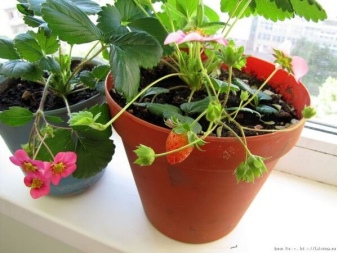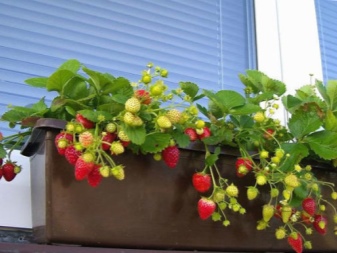Features of growing strawberries and strawberries on the balcony

Few people will refuse to regularly feast on strawberries and strawberries, without even leaving the walls of their apartment. Fortunately, it is quite possible to grow these crops on an ordinary city balcony.


Advantages and disadvantages
All year round, strawberries and a dugout on the balcony grow under the condition of good glazing, as well as the presence of constant illumination, the effect of which lasts at least 6 hours. In other cases, you can enjoy the sweetest berries during the traditional harvest season. In principle, growing berries at home has practically no drawbacks - unless you have to pay enough attention to caring for the plants. There are a lot of advantages: an excellent harvest is always at hand, and in some cases, even in winter, the planting system does not take up much space, and therefore can be placed even on a small balcony.
It is also considered a plus that insects or diseases are very quickly detected, and therefore eliminated.

Suitable varieties
For growing berries at home, it is recommended to select remontant varieties. They will bear fruit twice a season, and the first time may well occur within a couple of months after the direct disembarkation. The advantage is that such varieties are able to form fruit even in low light. Experienced gardeners recommend paying attention to "Supreme"yielding a large number of very sweet fruits, and "Queen Elizabeth II", the berries of which are distinguished by their characteristic sourness. A plentifully fruiting variety receives good reviews. "Darselect", the weight of the fruit of which sometimes reaches 80 grams. It is impossible not to turn your attention to "Homemade delicacy" with a small root system that fits perfectly in small containers.


If it is possible to mount suspended structures on the loggia, then it is worth taking ampel varieties, the length of the shoots of which can be 30 centimeters.
For example, we are talking about "Tuscany", "Roman" and "Alyuba". Suitable for a north-facing balcony Elvira and Temptation, whose strong immunity is not afraid of even unfavorable conditions. Having given preference "World debut", you will be able to enjoy not only the sweetest fruits, but also graceful dark pink buds. Of the strawberry varieties for home breeding, aromatic and constantly blooming is most suitable "Tuscany".


How can you grow?
Homemade berries are bred in different conditions, but when choosing a particular container, you should always remember that the smaller its volume, the smaller the lump inside will be, which means that the plant will lack nutrients. Quite original, but at the same time, it is convenient to grow strawberries in plastic bottles. To do this, a two-liter container is first cut in half. The part that is screwed on with the lid is pierced in several places and filled with soil mixture. It is in it that the culture is planted, after which the structure is installed in the lower part of the bottle, already filled with water.

In hanging pots
Hanging pots are most often used for strawberries, although strawberries feel quite comfortable in them. When choosing such containers, it is important to adhere to one important rule: the volume of the container cannot be less than 2.5 liters.
Such pots are attached either on a horizontal stick or on a hook.

On whatnots
A shelf for strawberries with strawberries can be purchased ready-made, or you can make it yourself from wooden slats or metal rods. An unusual design is a pyramidal shelf made up of containers. Its lower level looks like a wide pots, in which 5-6 bushes grow, and a towering cylinder is fixed in the middle. A smaller capacity is fixed on it, and the uppermost tier, created in the same way, already accommodates one bush.

In boxes
It is perfectly acceptable to grow berries in wooden boxes. Planting bushes should be carried out in such a way that at least 15 centimeters are kept between the seedlings.
In addition, it is important that the bottom of the container is dotted with drainage holes.

Suitable soil
For a remontant culture, a nutritious soil with high-quality aeration is required. Even if a high-quality soil mixture is initially purchased for the berries, it will still have to be loosened regularly. In addition to the universal mixture purchased in the store, you can use a mix of peat and perlite, taken in equal quantities. A combination of black soil, peat and humus, taken in equal proportions and diluted with a small amount of sand, will be very nutritious. The last component will have to be taken necessarily coarsely and cleared of clay. If sawdust is added to the mixture, then they will first need to be impregnated with urea.
Whichever land is chosen, it must be disinfected before planting plants. Most often, the procedure is carried out in the oven: it will be enough to warm up a filled pan for 10 minutes at a temperature of 200 degrees. You can also use the microwave or even just scald the mixture with boiling water. After disinfection, the soil should "rest" for some time in a cool place, where the temperature does not exceed 5 degrees.


Landing
Growing balcony strawberries and strawberries from seeds is considered a very time consuming process. Capricious seedlings usually require very careful care and die at the slightest oversight of the gardener. However, if this method is chosen, then it will be possible to increase the likelihood of success if the seed is preliminarily stratified. First, the seeds will need to be soaked for a couple of days, wrapped in a moistened gauze or a piece of paper towel. Further, when they swell, the bones will have to be placed in a container with ventilation holes, filled with soil, and put into the refrigerator for almost a month.
During this period, the "blanks" should be regularly moistened. It would be even better to spread a layer of snow over the ground, and sow seeds over it. After that, the container, covered with cling film, is located in a well-lit area.
When there are already 4 leaf blades on each sprout, they can be dived.

It is much easier, especially for a novice gardener, to plant purchased seedlings of crops. You should choose healthy bushes with 5-6 dense leaves and light roots. Already from the middle of spring, it is taken out to the balcony: if it is closed, then the air temperature does not play a special role, but when it is open, you will have to wait +10 degrees at night. When transplanting bushes into permanent containers, they should be deepened, but not too much, and also leave a gap equal to 2-3 centimeters from the ground to the edge of the container.
Optimal daylight hours for crops should be 8 to 12 hours. It can be lengthened if necessary thanks to the use of special lamps. On the loggia, the daytime temperature should be maintained at 20 degrees, and also at night - not falling below 15 degrees. The required humidity level reaches 60%. We must not forget about the importance of regular ventilation.

Care
A balcony culture that lives in a container of limited volume requires a sufficient amount of nutrients. Fertilizers, which can be both organic and inorganic, must contain potassium, nitrogen and phosphorus. Potassium will make the fruit taste sweeter, and nitrogen will allow you to build up a good green mass in a timely manner.
If you feed the berries with phosphorus in a timely manner, then you can be sure that the root system will not experience difficulties with development. From organic matter, strawberries with strawberries prefer wood ash and humus. Suitable inorganic fertilizers include superphosphates, potassium sulfate and urea. In principle, it will be much easier to care for crops on the loggia if you purchase ready-made mineral complexes in the appropriate stores.
In order not only to grow the bushes, but also to harvest from them, you will have to make top dressing twice a month. If the seeds were initially involved, then the first time you will have to use fertilizers in a couple of weeks after the first shoots appear. Purchased seedlings are fed upon completion of adaptation, the duration of which usually does not exceed two weeks. Balcony berries love abundant irrigation, but they can die if moisture stagnates in the pot. To avoid a problem, holes must be cut at the bottom of the container, and a drainage layer must be present in it.
Regular loosening of the topsoil will also be a plus.

Water for irrigation should be soft, as strawberries and strawberries react poorly to mineral salts. During irrigation, it is important to act carefully, excluding the ingress of drops on the leaf plates. In order for the breeding process of the culture to be automatic, it is initially worth purchasing self-pollinated varieties. To “activate” the process, it will be enough to run a watercolor brush over the flowers and thereby shake the pollen. A similar effect will be provided by a fan placed next to the plantings and operating at minimum power.
Another important component of grooming is to break off the whiskers that tend to root. If their quantity becomes excessive and begins to "take" resources from the mother bush, both the size and taste characteristics of the berries may suffer. Regular spraying of plants can also be added to the care procedures.

In order to preserve the bushes in winter, in the fall they will need to be freed from all the shoots from which the berries were previously plucked. Before wintering, it will not hurt to moisten the soil. The rules for the preservation of balcony crops also imply the use of a pair of cardboard boxes of similar, but still slightly different dimensions. First of all, the bottom of the large box is covered with a layer of foam balls or sawdust.
Further, a smaller storage is placed inside it, and the remaining voids between them are also filled with insulation. Containers with berry bushes are placed inside the smaller box. The soil in them, if desired, is also covered with sawdust. Strawberries and strawberries harvested for the winter should be periodically ventilated and irrigated, but only in the case of not too low temperatures.














The comment was sent successfully.